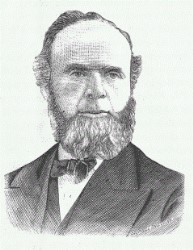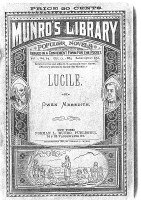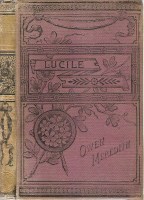PUBLISHER: Norman L. Munro, New York, 1873-1921
ABOUT: In 1883 moved to 24-26 Vandewater Street; in 1888 Munro Library plates were sold to John W. Lovell. (DLB 49). Schurman includes some further information about this company, and Shove has three pages on Munro and the Riverside Library; see research tools.
1873---NORMAN MUNRO: Brother of George Munro, Norman worked for him until 1873 when he issued the New York Family Story Paper. This started a big feud with George who resented the competition. According to legend, the two men never spoke to each other after that. Operating under his own name, Norman started, "Munro's Library" and "Munro's Pocket Magazine". 1876 -- A fire destroyed his building. 1877-- He launched the "Riverside Library". The books were almost identical to George Munro's Seaside Library. 1879 -- Riverside Library was discontinued, unable to compete with more established series. 1884 -- Norman began "Munro Library". It did very well until George filed a law-suit against Norman. The courts ruled for Norman, claiming he had as much right to the name Munro as George did. 1888 -- Norman sold Munro Library (825 sets of plates and 1,500,000 books) to John Lovell for $250,000 and retired. Following an appendectomy, Norman died in 1896, the same year his brother George died. [From Hyde Park Book Store, Boise, Idaho.]
“Norman L. Munro,” Biographer 1:19-21 (1883).

The imprint containing the words "George "Munro" is the most, familiar in the United States. As the manufacturer of twenty thousand more or fewer, books, six days of every week, Mr. Munro is ranked among the leading men of business in this country. He supplied the people with cheap copies of all such new books, produced in English or other language, as they are likely to read; and with handsome reprints of standard works, and the most intellectual (if the expression may be allowed) of English magazines, at a nominal price for each copy. The natural consequence of this enterprise is, that the majority of readers in this country encourage it, taking the business view of its convenience to them and disregarding the croakings of those either misinformed or untruthful writers who speak of Mr. Munro as a pirate," charging him unjustly with, in the absence of an international copyright law, appropriating the work of foreign writers without paying for it. So far from doing this, Mr. Munro takes care to remunerate the authors of all the foreign books reprinted by him, excepting of such the copyright of which has expired, although of course, under no obligation to do so; and he has yet to hear a complaint of unfair treatment from any one of these persons. That Mr. Munro is able to be on the best of terms with foreign writers, to publish new and attractive books at ten cents or twenty cents a copy, and to become wealthy as the result of doing this, possibly may be a grievance to those whose interests lie, as they mistakenly think, in maintaining a high price of books. Our belief is that the more cheap books are sold, the more copies of costly editions of the same works will be in demand. The interests of all publishers are in the direction of creating the number of people who read and appreciate books. Of almost every one it is true that he desires to possess a fine edition of a book he loves.
George Munro, who supplies the million with exclusively wholesome works, is a native of Neva Scotia, and is in the prime of life. He was educated at Dalhousie College, Halifax, an institution subsequently endowed by him with chairs of physics, political economy and history, and English literature and metaphysics; and with gifts of bursaries and exhibitions aggregating several thousand dollars yearly. After he was graduated Mr. Munro remained in college for a time as tutor, Having determined upon a business life, he left Halifax for New York about twenty-one years ago, and soon found employment with the American News Company of that city. He remained with the company until he had acquired sufficient experience and capital to begin business on his own account, His first venture was The Fireside Companion, a weekly magazine , the initial number of which was produced November 2, 1867. Its circulation increased in a most gratifying manner, and is now about a quarter of a million copies a week. The republication from this journal of stories and other matter in cheap book form led to the second of Mr. Munro's great enterprises, namely. the establishment of the Seaside Library, the first number of which was published May 20, 1877. "East Lynne" has been followed by about sixteen hundred other works, in editions never of fewer than ten thousand copies, and aggregating a total of many million books. As a new book is printed and published six days of every seven, it is impossible to be exact in the use of figures.. American, English, French and German authors arc represented in the long catalogue of the Seaside Library. Works of American authors and translations are copyrighted, The form of the library is large quarto pamphlet. 1t comprises many hooks of information as well as works of fiction, and both are admirably selected and published in time to meet the convenience of the best-informed readers.
On the twentieth of May, 1881, the English public were given the Revised version of the New Testament. The next morning were published two numbers of the Seaside Library, each containing one hundred and twenty pages, on which were printed the King James and Revised versions side by side, with marginal notes and the list of readings preferred by the American members of the Committee of Revision, the preface of the new version, and an introduction by Constantine Tischendotf of Leipzig. giving on [sic] account of the Vatican, Alexandrian and Sinaitic manuscripts, and readings from them. This is probably the most notable instance on record of rapid work in the production of books.
Mr. Munro's “Die Deutsche Library," begun March 30, 1881, is published semi-weekly at prices as low as those of the Seaside Library. The first number of his New York Monthly Fashion Basar, was issued November, 1879. It has a large circulation, owing in part to its beautiful colored illustrations. The best educated Americans are indebted to Mr. Munro for his. cheap but handsome reprints of the Contemporary Review, the Nineteenth Century, and Fortnightly Review, begun respectively in July, August, and September of 1879. Mr. Munro pays the English publishers for the use of their matter, and the proprietors of the Nineteenth Century and Fortnightly Review, send him advance sheets.
The Munro publishing establishment consists of two large connected buildings, one of them new, thoroughly provided with the means to the most economical and rapid production of hooks. His employees are well paid and always prompt and cheerful to undertake an exceptionally big job, as that of producing the New Testament for example.
Mr. Munro) is a man who is much beloved. He is courteous and gentle, diligent and sagacious in business, as the above account indicates, and able consequently to maintain very considerable charities, as well as to live in the enjoyment of the comforts and elegancies of life, and to enlarge the scope of his business as opportunity serves. He adheres to the faith in which he was educated, and is a devout member of the church under the pastoral charge of the eminent Dr. John Hall.
New York Times, Feb. 5, 1894, page 1: DEATH OF NORMAN L. MUNRO; OPERATION FOR APPENDICITIS RESULTED FATALLY. His Wife and Daughter by His Side When He Expired at the Hoffman House -- His Eleven-Year-Old Son is at Dobbs Ferry, Recovering from the Same Kind of an Operation -- Busy Life of the Well-Known Publisher and Yacht Owner.
Norman L. Munro, the millionaire publisher and owner of famous steam yachts, died at the Hoffman House at 6:30 o’clock last evening. His death resulted from an operation for appendicitis. / By a strange coincidence, Mr. Munro’s only son, Henry, eleven years old, is just recovering from an operation of the same kind that caused the death of his father. The son is at school at Dobbs Ferry, and last Monday Dr. Robert Abbé of 11 West fiftieth Street, performed an operation and removed the vermiform appendix. / Mr. Munro was taken ill Tuesday. Appendicitis was found to be his ailment, and Friday his physicians, Dr. Abbé and Dr. Weir of the New-York Hospital, decided that the possibility of saving his life lay in the operation to remove the vermiform appendix. This was performed that same day. / Drs. Dunham, Cushman, and Pease were in constant attendance, and Drs. Abbé and Weir, who performed the operation, made several visits. / Mrs. Munro had been with her son at Dobbs Ferry since his illness began until she was summoned to this city by the serious illness of her husband. Mrs. Munro and her daughter Norma, who is attending school in Tarrytown; James A. Blanchard, Mr. Munro’s counsel, and Drs. Cushman, Dunham, and Pease were with Mr. Munro when he died. George Munro, his brother, had been with him since his condition became serious, but had been called away a few hours before the end.
Mr. Munro formerly lived in West Fifty-seventh Street, but he sold his city home last Spring, and his home at Long Branch was kept open this Winter. Very recently he was confined to his house for two months by an attack of rheumatism. He had been at the Hoffman House several days, when he was attacked by his last illness. His lawyer, Mr. Blanchard, said last night that he had been to dinner with Mr. Munro only a week ago, and that he had never seen him looking better in his life. Mrs. Munro was at Long Branch when the news of the illness of her son at Dobbs Ferry called her away. / George Munro reached the Hoffman House soon after his brother’s death, as did also Dr. Abbé, who had been on a visit to Mr. Munro’s son, and reported that his chances for recovery were good. / The arrangements for the funeral were not completed last night.
Mr. Munro was estimated to be worth between $3,000,000 and $5,000,000. His fondness for fast steam yachts made him famous in the yachting world. He was also fond of fast trotting horses, and, while he never entered any of them in a race, he was the owner of several valuable ones. / Norman L. Munro was born in Millbrook, Pictou County, Nova Scotia, fifty-one years ago [i.e., 1843]. He was the son of a Nova Scotia farmer, and when he came to New-York, in 1864, he possessed only a few hundred dollars, a rugged constitution, and an untiring perseverance. His first work in the city was in a publishing house, where he was employed as a clerk. He was bright and keen-witted, and in a few years had mastered the details of the business. / By practicing the strictest economy, he amassed a sum of money sufficient to start himself in the publishing business on a small scale. His first business venture was in 1873, when he started The Family Story Paper. It was in September, during the financial panic, but in spite of it Mr. Munro set to work in the narrow, cramped building 169 William Street, and from there sent out the first edition of his paper. The paper was an unpretentious sheet, but it was not long before it began to attract attention, and in less than two years the business grew so that it was moved to 28 and 30 Beekman Street. This building was burned in 1876, and it was on this occasion that the energy which brought Mr. Munro from poverty to prosperity was called into play. / Several other publications had been started by Mr. Munro, and at the time of the fire the editions were ready for distribution by the news companies. The papers were nearly all destroyed. Mr. Munro at once went to work to get out a second edition. Some of the papers had been saved, and with the aid of what compositors he could find at the time, he had a new edition ready for the news companies on time. / After the fire the business was moved to the building in Vandewater Street which was erected by Mr. Munro. In 1893 the upper part of this building was destroyed by fire, the damage being about $60,000.
Mr. Munro’s business grew steadily until it was one of the largest publishing houses in the city. The circulation of The Family Story Paper, it is estimated, is about 300,000 a week. / Mr. Munro was interested in yachting. He had the steam yacht Norwood constructed upon his own ideas. On several occasions he loaned the yacht to the Government. He also purchased the Vamoose. He owned considerable real estate in this city. / It was always Mr. Munro’s ambition to own the fastest steam yacht afloat, and he spent many thousands of dollars on this hobby. He first owned the Norma, a 150-foot steamer. This boat was fast and was fitted up in palatial style. He then commissioned the Herrreshoffs to build the Now Then, which was to be faster than the Stiletto, the crack boat of that time. / The Now Then did not meet all Mr. Munro’s requirements, and she was sold to J. Edwards Addicks of Boston. The Henrietta was the next boat he owned. This was little more than a launch, but it beat Jay Gould’s fast yacht Atalanta over the Sound course. The Henrietta was disqualified, and Mr. Munro was so angry that he challenged Mr. Gould for a race for $10,000 a side. The Henrietta was sold to Commodore E. D. Morgan. Then came the Say When. / The Norwood was his fastest yacht. She is said to have steamed a mile in 1:58. She steamed a mile off Bay Ridge in 1892 in 2:12. The Norwood was raced against all the crack steamers of the harbor and river and made circles around them. A race was arranged with the Vamoose, but it did not come off, and last year Mr. Munro surprised yachtsmen by purchasing the Vamoose for $10,000. / He said he would put the boat in commission and allow the Herreshoffs to put their own engineer and fireman on board, and if the Norwood did not beat her he would present the Norwood to some charitable organization. Last year he had the sixty-foot launch So So built, which he used on the Shrewsbury River. / When the Norwod was build, Mr. Munro figured out how a boat built on her model and with more powerful engines could cross the Atlantic in four days. He even had a 200-foot steamer designed, but the boat got no further advanced than the plans on paper.
It is a well-known fact that the Family Story Paper is for sale including the entire plant connected with it. The will of Norman L Munro called for an immediate transfer of the property. The asking price for this enterprise is one milli9on dollars, and when the times are considered, it can be readily realized why the property has not been sold. It is understood that cash alone can enter into this sale. The business connected with this house is running along as smoothly and successfully as when Mr. Munro was alive. The business is said to average as well as it did a year ago, which speaks very well for the present management. However, when it is considered that it is the same management as for many years, this condition of affairs can be readily grasped. The business management is now under the charge of Mr. Hugh Fraser, for many years the confidential friend and adviser of Mr. Munro. As this gentleman understands every detail that made this weekly a great success, no apprehension is felt that it will deteriorate in value while under his care. [American Newsman 1894-07 p5].
LUCILE’s ISSUED BY Norman L. Munro:


Last revised: 4 February 2024